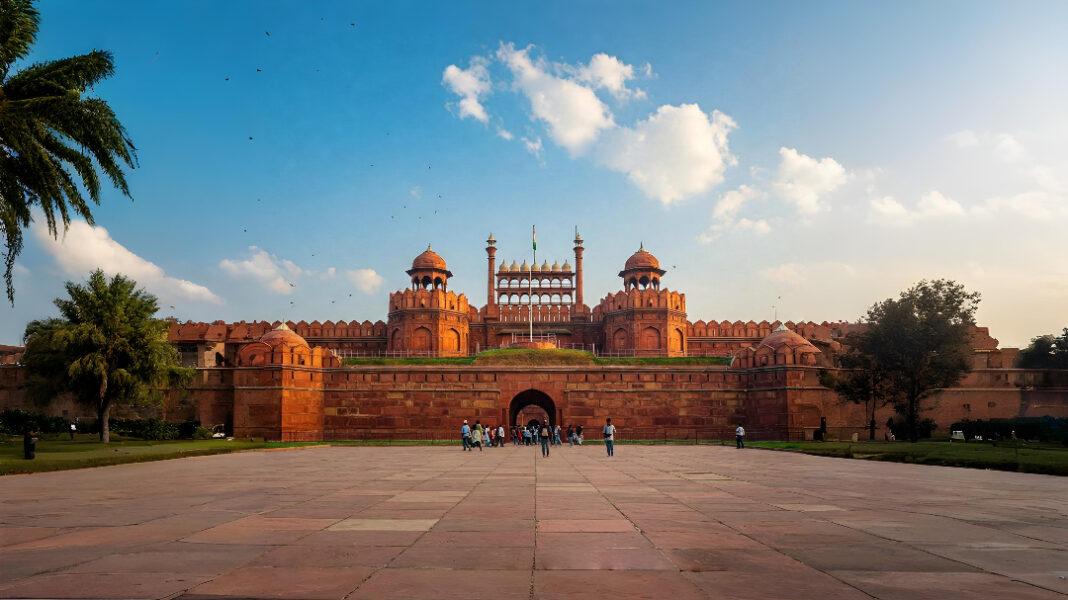Top 10 Best Places to Visit in India for 2025. India is a land where ancient traditions meet modern life. It’s a traveler’s dream. The mix of cultures, landscapes, and histories offers something for everyone. You may be drawn to the beauty of the Taj Mahal, the spirit of Varanasi, or the rugged charm of Ladakh’s Himalayas. From the busy streets of Delhi to the calm backwaters of Kerala, every place tells a unique story of India’s heritage and beauty.
This guide highlights the Top 10 Best Places to Visit in India for 2025. It provides insights on how to get there, where to stay, what to eat, and how to budget. No matter if you love history, crave adventure, or want peace, this guide will inspire your journey through India’s heart and soul.
Contents
- 2. Jaipur, Rajasthan
- 3. Asceticism in Varanasi, Uttar Pradesh
- 4. Kerala Backwaters, Alleppey, Kerala
- 5. Goa
- 6. Ladakh, Jammu & Kashmir
- 7. Delhi
- FAQs
- When is the best time to visit India?
- Do I need a visa to travel to India?
- How much should I budget for a trip to India?
- Is India safe for solo travelers?
- What should I pack for India?
- How can I stay connected in India?
- What are must-try foods in India?
- How do I get around within cities?
- Are there any cultural etiquette tips?
- Can I visit multiple best places to visit in India in one trip?
- 10. Can I visit multiple best places to visit in India in one trip?
- Conclusion
1. Taj Mahal, Agra, Uttar Pradesh
The Taj Mahal, one of the best places to visit in India, is a UNESCO World Heritage Site and a global symbol of love. It symbolizes love. Emperor Shah Jahan built it in the 17th century for his wife, Mumtaz Mahal. This white marble mausoleum is famous for its symmetrical design and peaceful atmosphere. The complex features gardens, mosques, and a museum. You get the best views at sunrise or sunset. Nearby, Agra Fort and Fatehpur Sikri offer more historical experiences.
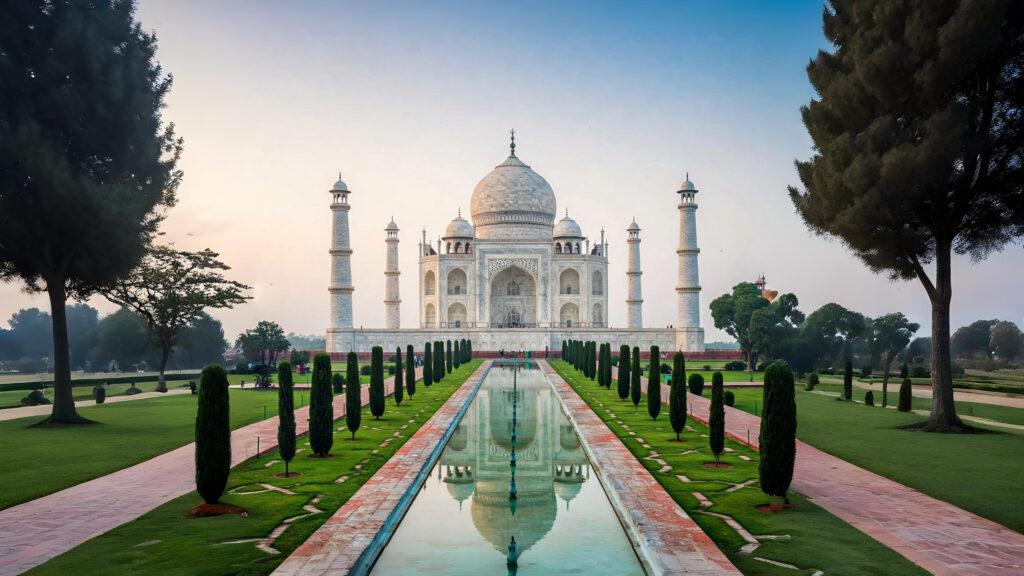
How to Reach
- By Air: Fly to Delhi’s Indira Gandhi International Airport (214 km), then take a taxi or train to Agra, a hub for the best places to visit in India.
- By Train: Agra Cantt Railway Station is well-connected to Delhi, Mumbai, Jaipur, and other cities. The Gatimaan Express from Delhi takes about 1.5 hours.
- By Road: Agra is 214 km from Delhi via the Yamuna Expressway (3-4 hours). Buses and taxis are available from Delhi, Jaipur (224 km), and Lucknow (419 km).
- Local Transport: Auto-rickshaws, cycle rickshaws, and taxis are common. Prepaid taxis from the railway station cost ₹200-₹500.
Hotels
- Luxury: Oberoi Amarvilas (₹30,000-₹50,000/night) offers Taj views from every room. Jaypee Palace Hotel (₹8,000-₹15,000) blends luxury with Mughal aesthetics.
- Mid-Range: Hotel Taj Resorts (₹4,000-₹7,000) is close to the Taj Mahal. Crystal Sarovar Premiere (₹5,000-₹8,000) offers modern amenities.
- Budget: Hotel Sidhartha (₹1,500-₹2,500) is clean and near the Taj. Homestays like The Coral House (₹1,000-₹2,000) are affordable.
Travel Tips
- Visit at sunrise to avoid crowds and enjoy cooler weather. The Taj is closed on Fridays.
- Entry fees: ₹50 (Indian citizens), ₹1,100 (SAARC nationals), ₹1,300 (foreigners). Combo tickets with Agra Fort save money.
- Hire a certified guide (₹500-₹1,000) for historical insights. Avoid unofficial guides.
- Try petha and Mughlai cuisine at Pinch of Spice while exploring the best places to visit in India.
Budget
- Transport: ₹2,000-₹5,000 (round-trip train/flight from Delhi).
- Accommodation: ₹1,500-₹15,000/night.
- Food: ₹500-₹1,500/day.
- Entry Fees/Sightseeing: ₹1,500-₹3,000.
- Total (2 days, per person): ₹7,000-₹25,000.
2. Jaipur, Rajasthan
Jaipur, the Pink City, ranks among the best places to visit in India for its royal heritage. Its royal heritage shines through Amber Fort, Hawa Mahal, and City Palace. Vibrant markets like Johari Bazaar and cultural festivals like the Elephant Festival make it a traveler’s delight. The city’s rosy-hued architecture and Rajasthani cuisine (try dal baati churma) are unforgettable.
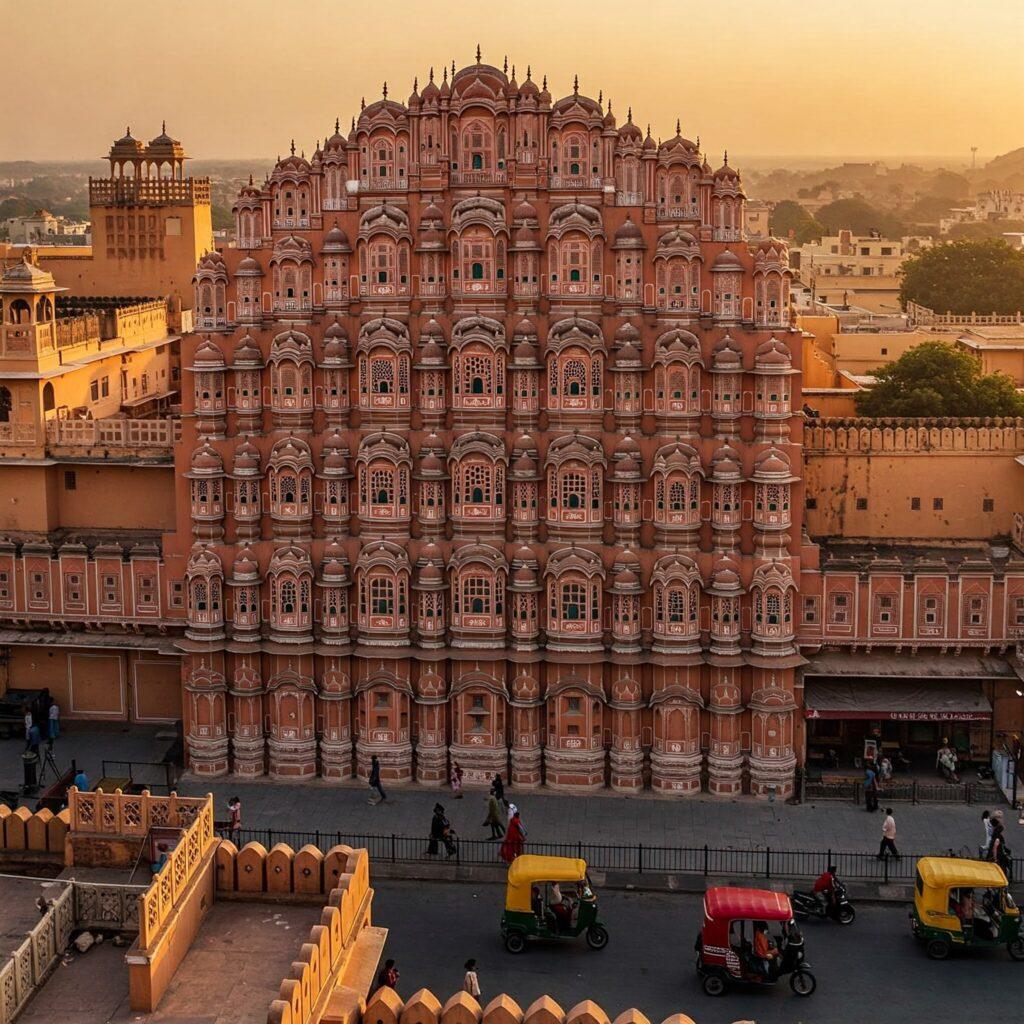
How to Reach
- By Air: Jaipur International Airport connects to Delhi, Mumbai, and Bangalore. It also has flights to international places like Dubai.
- By Train: Jaipur Junction is linked to Delhi (Shatabdi Express, 4.5 hours), Agra, and Mumbai. Daily trains are frequent.
- By Road: Jaipur is 268 km from Delhi (5-6 hours) via NH48. Buses and cabs are available from Agra (224 km) and Udaipur.
- Local Transport: Auto-rickshaws (₹50-₹150), Ola/Uber, and cycle rickshaws are common. Renting a car with a driver costs ₹2,000-₹3,000/day.
Hotels
- Luxury: Rambagh Palace (₹25,000-₹50,000) is a former royal residence. Fairmont Jaipur (₹15,000-₹25,000) offers regal vibes.
- Mid-Range: Alsisar Haveli (₹5,000-₹8,000) has heritage charm. Hotel Pearl Palace (₹3,000-₹5,000) is popular with travelers.
- Budget: Zostel Jaipur (₹500-₹1,500 for dorms) is great for backpackers. Vinayak Guest House (₹1,000-₹2,000) is clean and central.
Travel Tips
- Visit Amber Fort early to avoid crowds. Entry: ₹100 (Indians), ₹500 (foreigners).
- Shop for jewelry and textiles at Bapu Bazaar, but bargain hard.
- October to March is ideal due to pleasant weather. Avoid summer (April-June) due to heat.
- Book a guided city tour (₹1,000-₹2,000) for forts and palaces.
Budget
- Transport: ₹2,000-₹6,000 (round-trip from Delhi).
- Accommodation: ₹1,000-₹15,000/night.
- Food: ₹500-₹1,500/day.
- Entry Fees/Sightseeing: ₹1,000-₹2,500.
- Total (2 days, per person): ₹6,000-₹25,000.
3. Asceticism in Varanasi, Uttar Pradesh
Varanasi, one of the world’s oldest cities, is among the best places to visit in India for spiritual seekers. Located on the Ganges River, Varanasi is known for its ghats. Here, pilgrims perform rituals. The Ganga Aarti ceremony at Dashashwamedh Ghat is especially captivating. Ancient temples, narrow lanes, and the nearby Sarnath (Buddha’s first sermon site) offer a deep cultural experience.
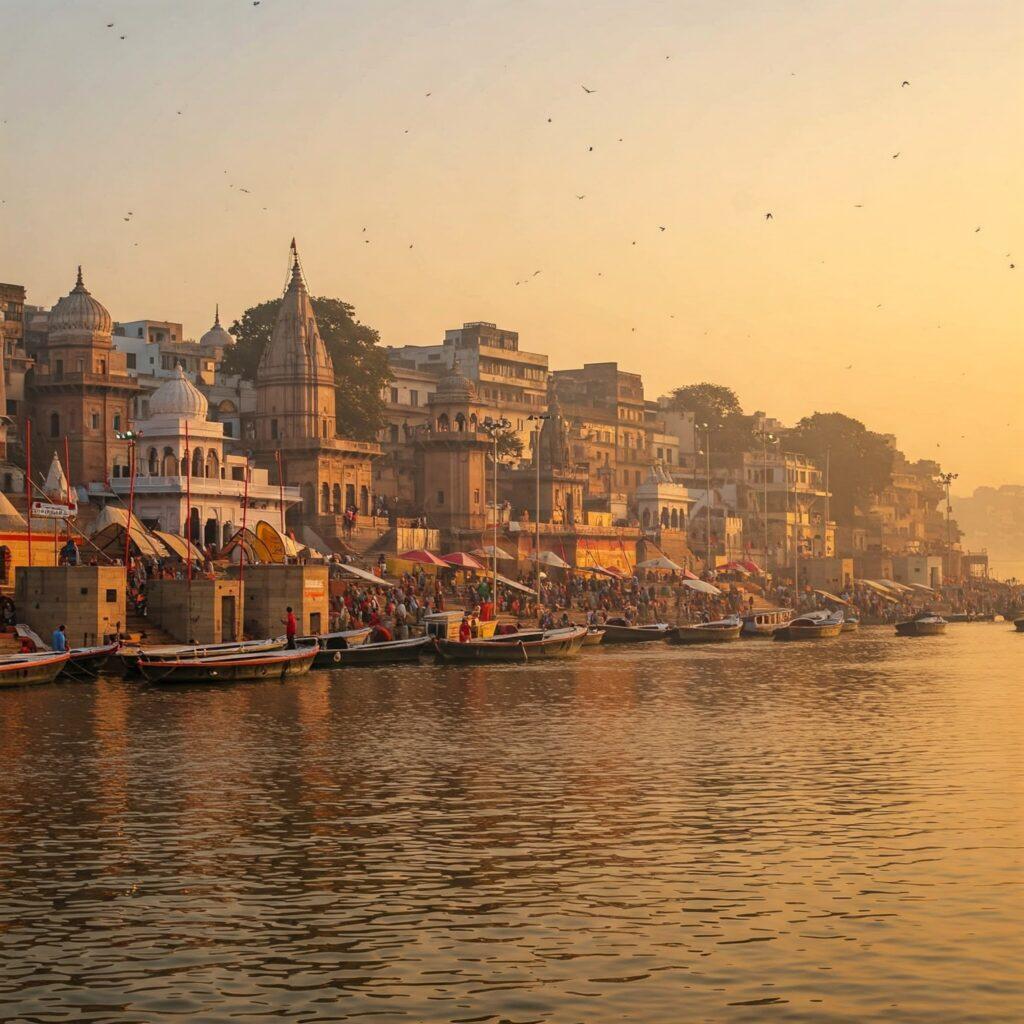
How to Reach
- By Air: Lal Bahadur Shastri International Airport connects to Delhi, Mumbai, and Kolkata. Taxis to the city center cost ₹500-₹800.
- By Train: Varanasi Junction is linked to Delhi (Kashi Vishwanath Express, 12 hours), Kolkata, and Lucknow.
- By Road: Buses from Lucknow (270 km, 6-7 hours) and Delhi (800 km, 14-16 hours) are available. Taxis are pricier (₹10,000 from Delhi).
- Local Transport: Auto-rickshaws (₹50-₹200) and cycle rickshaws navigate narrow lanes. Boats for ghat tours cost ₹500-₹1,500/hour.
Hotels
- Luxury: BrijRama Palace (₹15,000-₹25,000) is a heritage hotel by the Ganges. Taj Ganges (₹8,000-₹12,000) offers modern luxury.
- Mid-Range: Hotel Surya (₹3,000-₹5,000) is near the ghats. Ganges Grand (₹2,500-₹4,000) is comfortable.
- Budget: Stops Hostel (₹400-₹1,200 for dorms) is backpacker-friendly. Hotel Alka (₹1,000-₹2,000) overlooks the Ganges.
Travel Tips
- October to February is best for pleasant weather. Monsoons (July-September) can flood ghats.
- Ganga Aarti starts at 6:30 PM; arrive early for a good spot. Boat rides enhance the experience.
- Entry to ghats is free; temples may charge ₹20-₹50. Sarnath entry: ₹25 (Indians), ₹300 (foreigners).
- Try Banarasi sweets like malaiyo and shop for silk sarees at Godaulia Market.
Budget
- Transport: ₹2,000-₹5,000 (round-trip from Delhi).
- Accommodation: ₹1,000-₹15,000/night.
- Food: ₹300-₹1,000/day.
- Entry Fees/Sightseeing: ₹500-₹2,000.
- Total (2 days, per person): ₹5,000-₹20,000.
4. Kerala Backwaters, Alleppey, Kerala
The Kerala Backwaters in Alleppey are among the best places to visit in India for a serene escape. These waterways are surrounded by palm trees and paddy fields. A houseboat cruise offers a serene escape, showcasing village life and lush greenery. Nearby, Kochi’s Fort Kochi and Munnar’s tea plantations add variety to the trip.
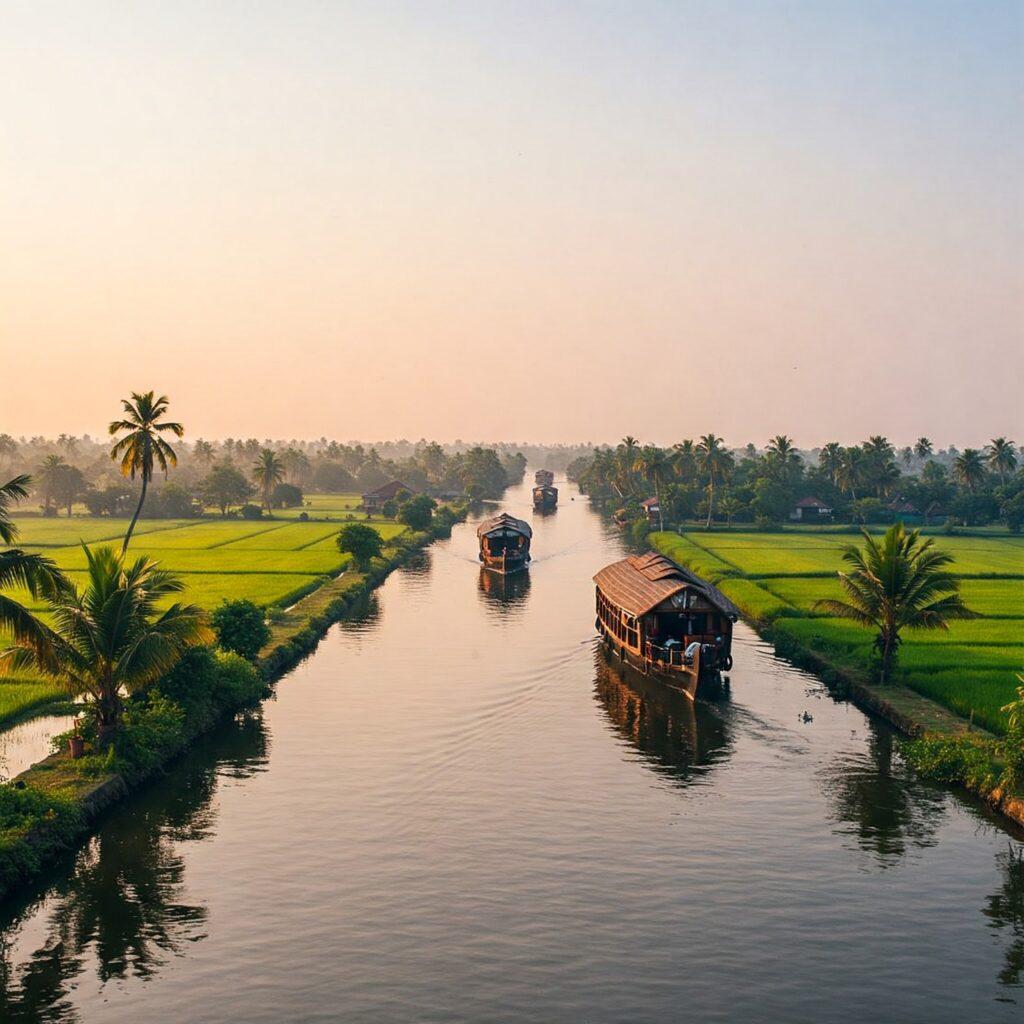
How to Reach
- By Air: Cochin International Airport (83 km) connects to Delhi, Mumbai, and international cities. Taxis to Alleppey cost ₹2,000-₹3,000.
- By Train: Alleppey Railway Station has trains from Ernakulam (1 hour), Chennai, and Bangalore.
- By Road: Buses from Kochi (2 hours) and Trivandrum (3.5 hours) are frequent. NH66 connects Alleppey to major cities.
- Local Transport: Auto-rickshaws (₹50-₹150) and taxis are common. Houseboats are the main attraction.
Hotels
- Luxury: Kumarakom Lake Resort (₹15,000-₹25,000) offers backwater views. Houseboats like Xandari Riverscapes (₹10,000-₹15,000/night) are premium.
- Mid-Range: Lake Palace Resort (₹4,000-₹7,000) is scenic. Budget houseboats (₹5,000-₹8,000) are widely available.
- Budget: Palmyra Residency (₹1,500-₹2,500) is clean. Homestays like Venice Castle (₹1,000-₹2,000) are cozy.
Travel Tips
- December to February is ideal for pleasant weather. Monsoons (June-August) are lush but rainy.
- Book houseboats in advance (₹5,000-₹15,000/night for 2-4 people). Check for AC and meals included.
- Try Kerala cuisine like appam and fish curry at local eateries.
- Visit during the Nehru Trophy Boat Race (August) for a vibrant experience.
Budget
- Transport: ₹2,000-₹6,000 (round-trip from Kochi).
- Accommodation: ₹1,000-₹15,000/night.
- Food: ₹500-₹1,500/day.
- Houseboat/Sightseeing: ₹2,000-₹5,000.
- Total (2 days, per person): ₹7,000-₹25,000.
5. Goa
Goa, India’s smallest state, is a coastal gem. It’s famous for its stunning beaches like Palolem and Anjuna. You can also explore its rich Portuguese heritage, especially at the Basilica of Bom Jesus. Plus, the nightlife here is lively and fun. From laid-back Anjuna to bustling Calangute, Goa blends relaxation with party vibes. Old Goa’s churches and Fort Aguada are historical highlights. Palolem and Anjuna beaches, along with Portuguese-era churches, create a unique vibe, cementing Goa’s spot among the best places to visit in India. Fort Aguada adds historical charm.

How to Reach Goa
- By Air: Dabolim International Airport connects to Delhi, Mumbai, and international destinations. Taxis to Panjim cost ₹800-₹1,500.
- By Train: Madgaon and Thivim stations link to Delhi, Mumbai, and Bangalore.
- By Road: Buses from Mumbai (12 hours) and Bangalore (10 hours) are frequent. NH66 is the main highway.
- Local Transport: Rent scooters (₹300-₹500/day) or use taxis (₹500-₹2,000). Buses are cheap (₹10-₹50).
Hotels
- Luxury: Taj Exotica Resort (₹15,000-₹25,000) is beachfront. The Leela Goa (₹12,000-₹20,000) is luxurious.
- Mid-Range: Casa Vagator (₹4,000-₹7,000) is near the beach. Alila Diwa Goa (₹5,000-₹8,000) is serene.
- Budget: Zostel Goa (₹500-₹1,500 for dorms) is vibrant. Sea View Cottages (₹1,000-₹2,500) are beachside.
Travel Tips
- November to March is peak season with pleasant weather. Monsoons (June-September) are quieter but rainy.
- Entry to churches and forts: ₹20-₹100. Beaches are free.
- Try Goan fish curry and feni (local liquor) at shacks like Curlies.
- Visit Saturday Night Markets in Arpora for shopping and food.
Budget
- Transport: ₹2,000-₹6,000 (round-trip from Mumbai).
- Accommodation: ₹1,000-₹15,000/night.
- Food: ₹500-₹1,500/day.
- Sightseeing/Activities: ₹500-₹2,000.
- Total (2 days, per person): ₹6,000-₹25,000.
6. Ladakh, Jammu & Kashmir
Ladakh is a high-altitude desert in the Himalayas. It has stunning views, Buddhist monasteries like Hemis and Thiksey, and the bright turquoise waters of Pangong Lake. Leh, the main town, is a hub for trekkers and adventure seekers. The Magnetic Hill and Khardung La Pass are unique attractions.
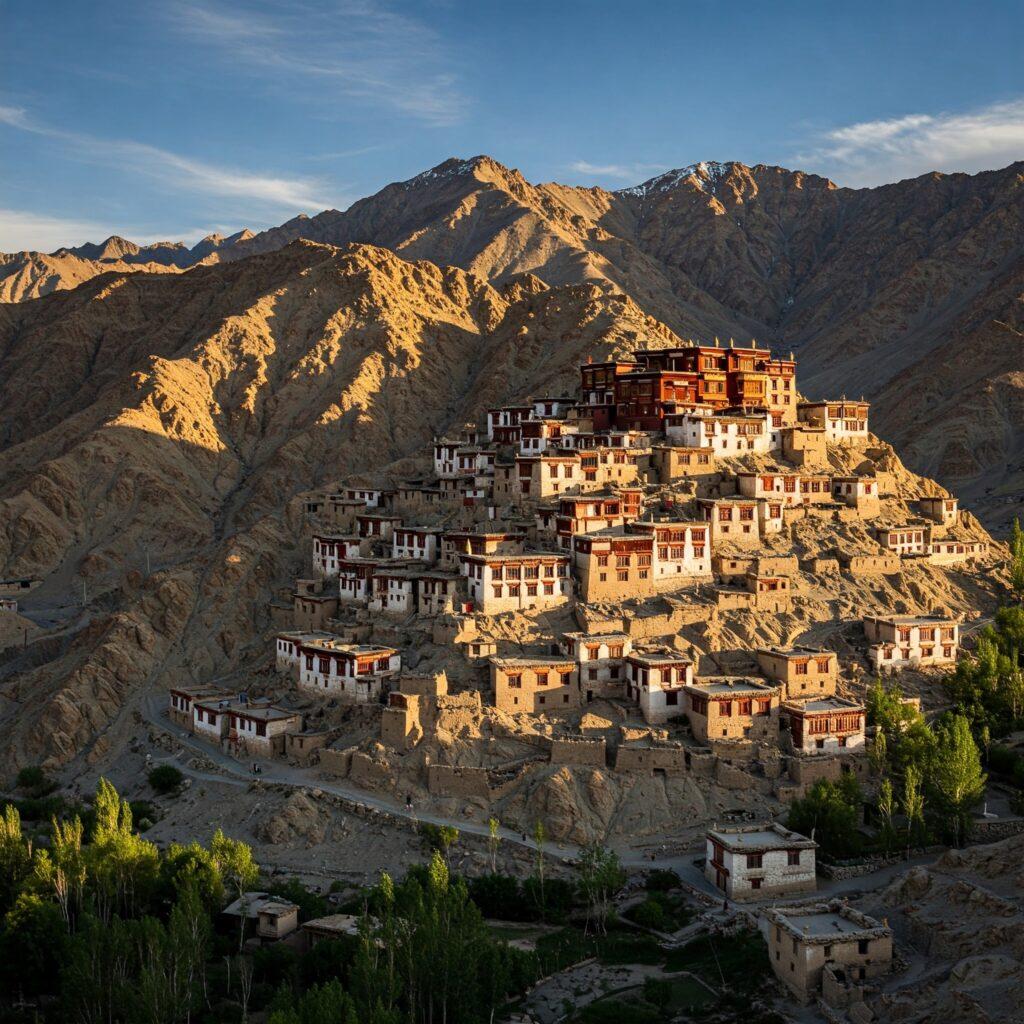
How to Reach Ladakh
- By Air: Kushok Bakula Rimpochee Airport in Leh has flights from Delhi, Srinagar, and Jammu. Taxis to Leh town cost ₹500-₹1,000.
- By Road: Buses and taxis from Srinagar (420 km, 2 days) or Manali (470 km, 2 days) are scenic but challenging. Roads open June-September.
- Local Transport: Taxis (₹2,000-₹5,000/day) and rented bikes (₹1,000-₹2,000/day) are common. Shared taxis to monasteries cost ₹200-₹500.
Hotels
- Luxury: The Grand Dragon Ladakh (₹8,000-₹15,000) offers comfort. Chamba Camp (₹20,000-₹30,000) is glamping.
- Mid-Range: Hotel Ladakh Palace (₹3,000-₹5,000) is central. The Silk Route (₹2,500-₹4,000) is cozy.
- Budget: Zostel Leh (₹500-₹1,500 for dorms). Gomang Boutique Hotel (₹1,500-₹2,500) is simple.
Travel Tips
- June to September is best; winters are harsh (-20°C). Acclimatize for 1-2 days to avoid altitude sickness.
- Permits (₹600) are needed for restricted areas like Pangong. Book through agents.
- Try Ladakhi momos and thukpa at Tibetan Kitchen.
- Carry cash; ATMs are limited. Pack warm clothing.
Budget
- Transport: ₹5,000-₹15,000 (round-trip flight from Delhi).
- Accommodation: ₹1,000-₹15,000/night.
- Food: ₹500-₹1,500/day.
- Sightseeing/Permits: ₹2,000-₹5,000.
- Total (3 days, per person): ₹10,000-₹35,000.
7. Delhi
India’s capital, Delhi, blends history and modernity. Old Delhi’s Red Fort, Jama Masjid, and Chandni Chowk contrast with New Delhi’s India Gate and Lotus Temple. Humayun’s Tomb and Qutub Minar are UNESCO sites, while Connaught Place buzzes with shops and cafes.
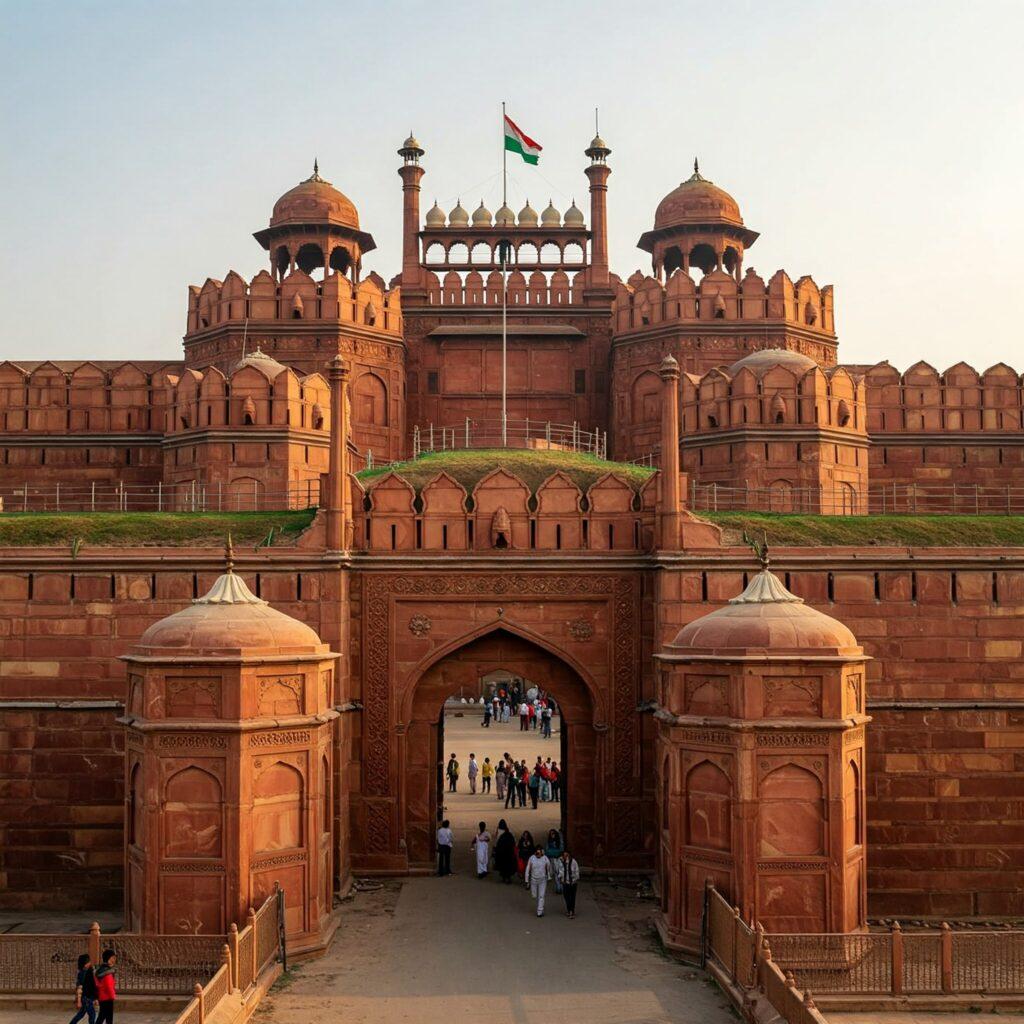
How to Reach Delhi
- By Air: Indira Gandhi International Airport is a major hub with global connectivity.
- By Train: New Delhi and Old Delhi stations connect to all major cities.
- By Road: Buses and taxis from Jaipur (5 hours), Agra (3-4 hours), and Chandigarh (4 hours).
- Local Transport: Delhi Metro (₹10-₹60) is efficient. Auto-rickshaws (₹50-₹200) and Ola/Uber are widely available.
Hotels
- Luxury: The Oberoi New Delhi (₹15,000-₹25,000) is elegant. Taj Mahal Hotel (₹12,000-₹20,000) is iconic.
- Mid-Range: Bloomrooms @ Janpath (₹3,000-₹5,000) is trendy. Hotel City Star (₹2,500-₹4,000) is central.
- Budget: Moustache Hostel (₹400-₹1,200 for dorms). Hotel Hari Piorko (₹1,000-₹2,000) is in Paharganj.
Travel Tips
- October to March is ideal. Summers (April-June) are scorching (40°C+).
- Entry fees: ₹30-₹100 (Indians), ₹500-₹600 (foreigners) for monuments.
- Try street food like chaat and parathas at Parathe Wali Gali. Avoid tap water.
- Use the metro for Qutub Minar and Lotus Temple to save time.
Budget
- Transport: ₹1,000-₹5,000 (round-trip from nearby cities).
- Accommodation: ₹1,000-₹15,000/night.
- Food: ₹500-₹1,500/day.
- Entry Fees/Sightseeing: ₹1,000-₹2,500.
- Total (2 days, per person): ₹5,000-₹25,000.
8. Amritsar, Punjab
Amritsar’s Golden Temple makes it one of the best places to visit in India for spiritual and cultural experiences. The temple’s serene Amrit Sarovar and free langar (community kitchen) are humbling. The Wagah Border ceremony and Jallianwala Bagh add patriotic and historical significance.
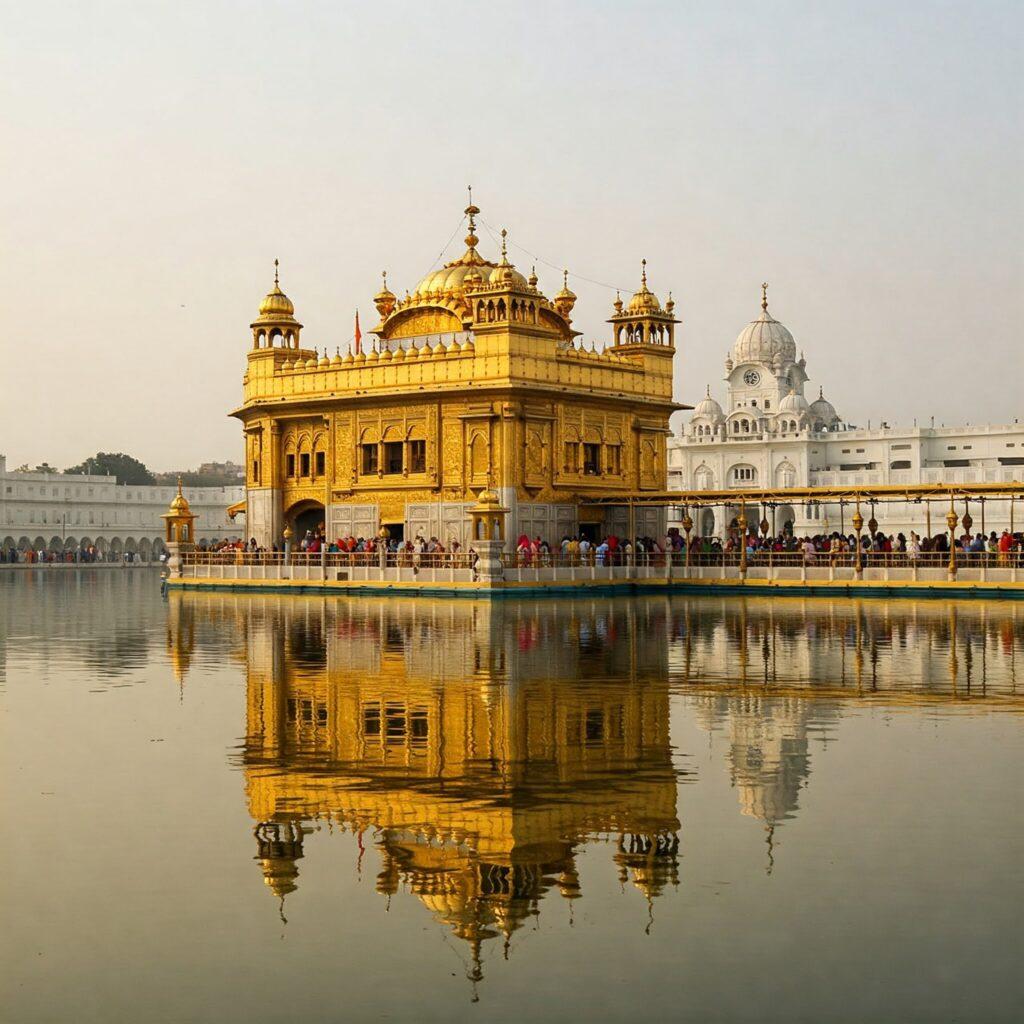
How to Reach Amritsar
- By Air: Sri Guru Ram Das Jee International Airport connects to Delhi, Mumbai, and Dubai. Taxis to the city cost ₹500-₹800.
- By Train: Amritsar Junction links to Delhi (Shatabdi Express, 6 hours) and Chandigarh.
- By Road: Buses from Delhi (450 km, 8-10 hours) and Chandigarh (225 km, 4-5 hours) are frequent.
- Local Transport: Auto-rickshaws (₹50-₹150) and cycle rickshaws are common. Taxis to Wagah cost ₹1,000-₹1,500.
Hotels
- Luxury: Taj Swarna (₹8,000-₹15,000) is modern. Hyatt Regency (₹6,000-₹10,000) is comfortable.
- Mid-Range: Hotel City Park (₹2,500-₹4,000) is near the temple. HK Clarks Inn (₹3,000-₹5,000) is reliable.
- Budget: Backpacker’s Nest (₹400-₹1,200 for dorms). Hotel Puri Palace (₹1,000-₹2,000) is simple.
Travel Tips
- October to March is best. Summers are hot; winters can be foggy.
- Golden Temple entry is free. Cover your head (scarves provided) and remove shoes.
- Wagah Border ceremony starts at 4:30 PM; arrive by 3:30 PM. Entry is free.
- Try kulcha at Kesar Da Dhaba, a highlight of the best places to visit in India.
Budget
- Transport: ₹2,000-₹6,000 (round-trip from Delhi).
- Accommodation: ₹1,000-₹10,000/night.
- Food: ₹300-₹1,000/day.
- Sightseeing: ₹500-₹1,500.
- Total (2 days, per person): ₹5,000-₹20,000.
9. Hampi, Karnataka
Hampi, a UNESCO World Heritage Site, was the capital of the Vijayanagara Empire from the 14th to the 16th centuries. This is a UNESCO World Heritage Site, is one of the best places to visit in India for history lovers. It has over 1,600 structures, like the Virupaksha Temple, Lotus Mahal, and the stone chariot at Vittala Temple. Matanga Hill provides stunning views. You can also enjoy peaceful coracle rides on the Tungabhadra River.
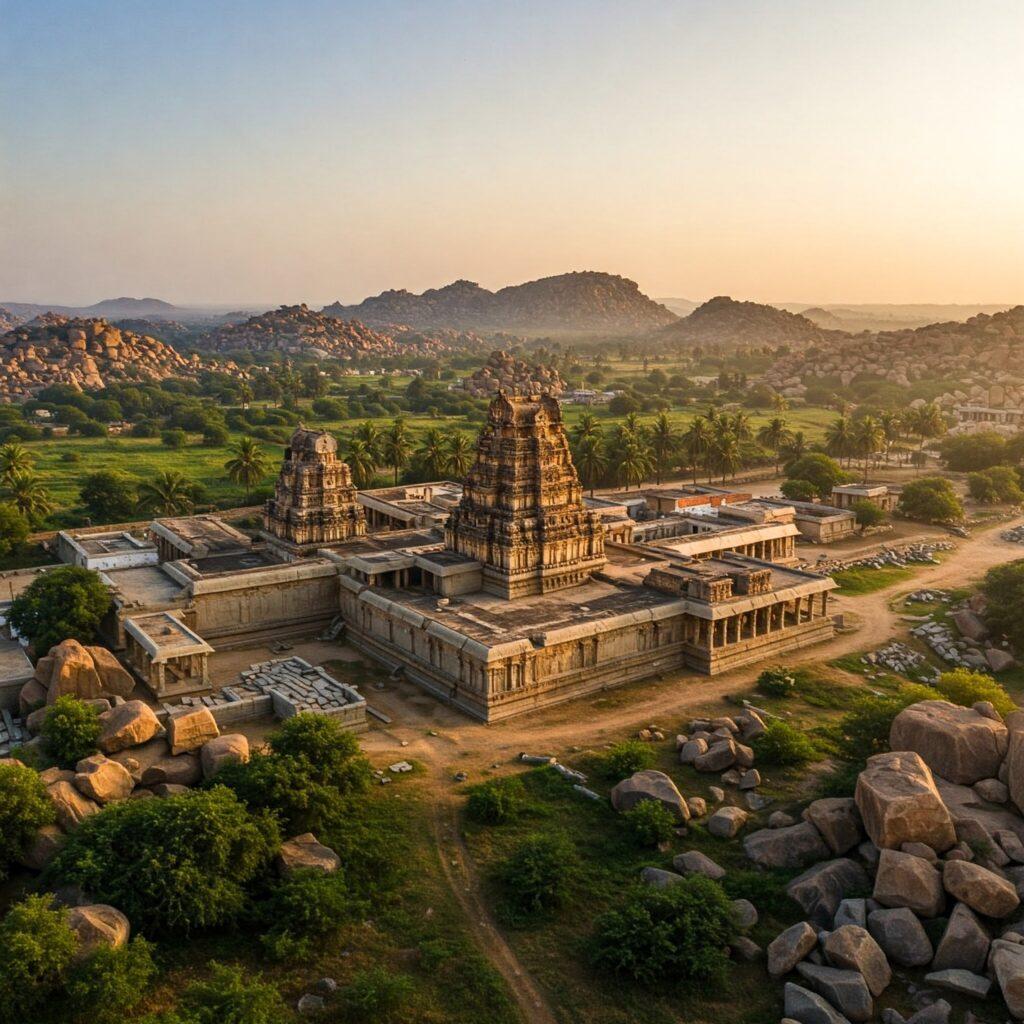
How to Reach Hampi, Karnataka
- By Air: The nearest airport is in Hubli (143 km). Bellary (60 km) has limited flights. Taxis cost ₹2,000-₹4,000.
- By Train: Hospet Junction (13 km) connects to Bangalore and Goa. Auto-rickshaws to Hampi cost ₹200-₹400.
- By Road: Buses from Bangalore (340 km, 7-8 hours) and Goa (310 km, 8 hours) are frequent.
- Local Transport: Rent bicycles (₹100-₹200/day) or scooters (₹300-₹500/day). Auto-rickshaws cost ₹50-₹150 per trip.
Hotels
- Luxury: Evolve Back Kamalapura Palace (₹10,000-₹20,000) is heritage-inspired. Heritage Resort Hampi (₹6,000-₹10,000) is serene.
- Mid-Range: Clarks Inn Hampi (₹3,000-₹5,000) is modern. Kishkinda Heritage Resort (₹2,500-₹4,000) is rustic.
- Budget: Rocky Guesthouse (₹800-₹1,500) is basic. Hampi’s Boulders (₹1,500-₹2,500) is scenic.
Travel Tips
- November to February is ideal. Summers (March-May) are hot (40°C).
- Entry fees: ₹40 (Indians), ₹600 (foreigners) for main sites. Virupaksha Temple is ₹20-₹50.
- Wear comfortable shoes for rocky terrain. Hire a guide (₹500-₹1,000) for context.
- Try South Indian meals at Mango Tree restaurant.
Budget
- Transport: ₹2,000-₹5,000 (round-trip from Bangalore).
- Accommodation: ₹800-₹10,000/night.
- Food: ₹300-₹1,000/day.
- Entry Fees/Sightseeing: ₹500-₹2,000.
- Total (2 days, per person): ₹5,000-₹20,000.
10. Rishikesh, Uttarakhand
Rishikesh, the “Yoga Capital of the World,” sits on the Ganges in the Himalayan foothills. Known for spiritual retreats and yoga ashrams, like the Beatles Ashram, this place offers both calm and thrill. You can enjoy adventure sports too, such as white-water rafting and bungee jumping. Laxman Jhula and Triveni Ghat are iconic spots.
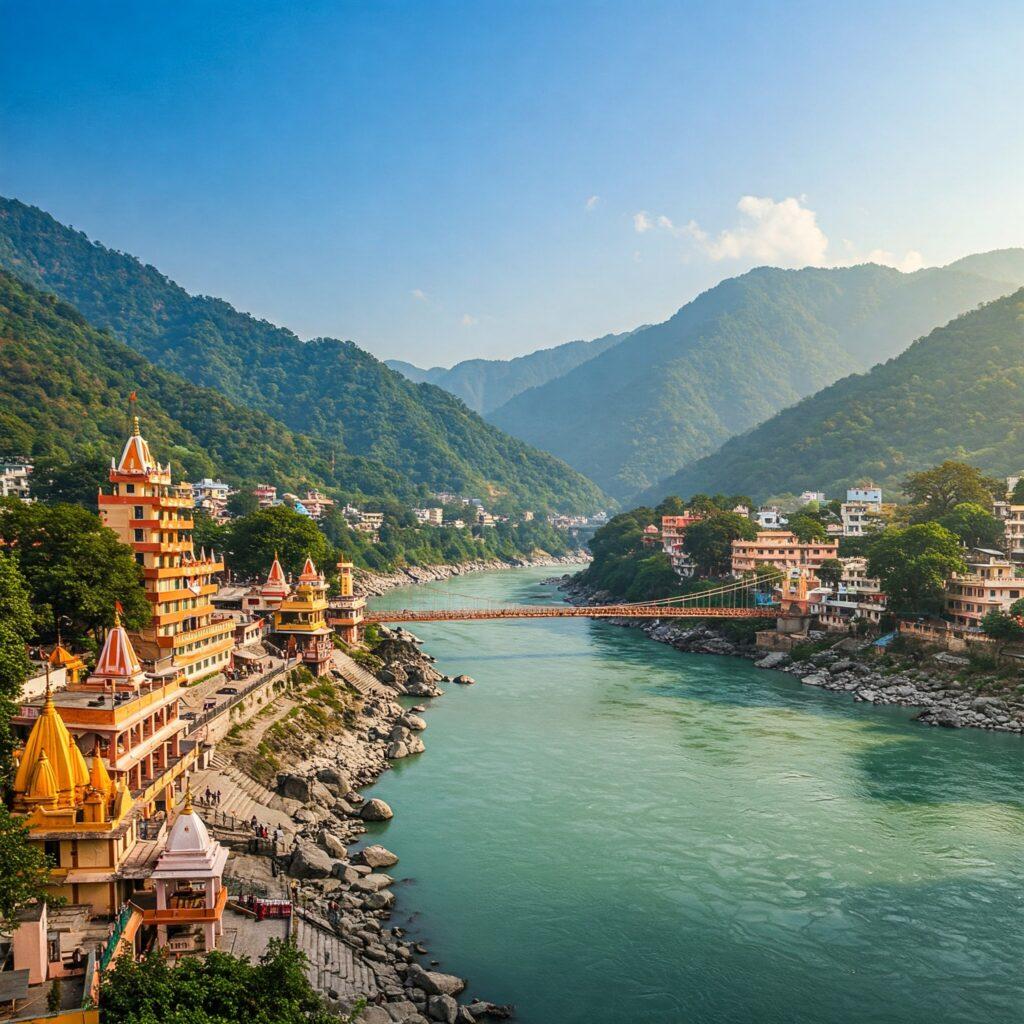
How to Reach Rishikesh, Uttarakhand
- By Air: Jolly Grant Airport in Dehradun (20 km) connects to Delhi and Mumbai. Taxis cost ₹500-₹1,000.
- By Train: Rishikesh Railway Station has limited trains. Haridwar (25 km) is better connected to Delhi (4-5 hours).
- By Road: Buses from Delhi (240 km, 6-7 hours) and Dehradun (45 km, 1 hour) are frequent.
- Local Transport: Auto-rickshaws (₹50-₹150) and shared jeeps (₹20-₹50) are common. Rent scooters for ₹300-₹500/day.
Hotels
- Luxury: Ananda in the Himalayas (₹25,000-₹40,000) is a wellness retreat. Taj Rishikesh (₹15,000-₹25,000) is riverside.
- Mid-Range: Divine Ganga Cottage (₹3,000-₹5,000) is scenic. Aloha on the Ganges (₹4,000-₹7,000) is modern.
- Budget: Swiss Cottage and Spa (₹1,000-₹2,000) is affordable. Live Free Hostel (₹400-₹1,200 for dorms) is vibrant.
Travel Tips
- February to May and September to November are best. Monsoons can cause landslides.
- Rafting costs ₹800-₹2,000 per person. Book through reputed operators like Himalayan River Runners.
- Entry to Beatles Ashram: ₹150 (Indians), ₹600 (foreigners). Triveni Ghat Aarti is free.
- Try vegan cafes like Bistro Nirvana, a gem among the best places to visit in India.
Budget
- Transport: ₹1,500-₹5,000 (round-trip from Delhi).
- Accommodation: ₹1,000-₹15,000/night.
- Food: ₹300-₹1,000/day.
- Activities/Sightseeing: ₹1,000-₹3,000.
- Total (2 days, per person): ₹5,000-₹25,000.
General Travel Tips for India
- Best Time: October to March suits most best places to visit in India. Ladakh is best June-September. Check specific seasons for each place.
- Visas: Foreigners need an e-Visa or tourist visa (apply online, $25-$80). Carry passport copies.
- Currency: Indian Rupee (₹). Carry cash for small vendors; UPI apps like Paytm, GPay, PhonePe are widely used in cities.
- Safety: Stick to bottled water, avoid street food if sensitive, and beware of pickpockets in crowded areas.
- Connectivity: Buy a local SIM (Airtel/Jio, ₹500-₹1,000 for 30 days) for data and calls. Wi-Fi is common in hotels.
- Clothing: Pack modest clothing for religious sites (cover shoulders and knees). Layer for Ladakh and Rishikesh.
Sample 10-Day Itinerary
- Day 1-2: Delhi (Red Fort, Qutub Minar, India Gate)
- Day 3-4: Agra (Taj Mahal, Agra Fort) and Jaipur (Amber Fort, Hawa Mahal)
- Day 5-6: Varanasi (Ganga Aarti, Sarnath)
- Day 7-8: Rishikesh (rafting, yoga, Laxman Jhula)
- Day 9-10: Amritsar (Golden Temple, Wagah Border) or Goa (beaches, nightlife)
This itinerary covers many of the best places to visit in India, blending culture, spirituality, and relaxation.
Total Budget for 10 Days (per person)
- Budget Traveler: ₹30,000-₹50,000 (hostels, buses, street food).
- Mid-Range: ₹50,000-₹100,000 (hotels, trains, local taxis).
- Luxury: ₹100,000-₹200,000 (flights, 4-5 star hotels, private cabs).
India offers a mix of experiences, from spiritual Varanasi to adventurous Ladakh. You’ll create memories that last a lifetime. Plan ahead, embrace the chaos, and enjoy India’s charm. For custom itineraries or details about specific places, visit trusted sites like IRCTC Tourism or Holidify.
Similar Posts:
- How to Reach Tirupati Balaji In 2025: Complete Guide to Visiting, Budgeting & Cultural Insights
- 12 Jyotirlingas of India: How to Reach & Explore
- How to Reach Andaman and Nicobar Islands: Your Ultimate Travel Guide in 2025
- How to Reach Dudhsagar Waterfalls: A Complete Guide in 2025
FAQs
When is the best time to visit India?
The ideal time is October to March, when most regions enjoy pleasant weather. Check specific destinations: Ladakh is best from June to September. Kerala’s backwaters are lush during the monsoon, which runs from June to August. Summers (April-June) can be hot, especially in Delhi and Rajasthan.
Do I need a visa to travel to India?
Yes, most foreign nationals require a tourist visa or e-Visa. Apply online at indianvisaonline.gov.in for an e-Visa ($25-$80, depending on duration). Ensure your passport is valid for six months. SAARC nationals may have different requirements.
How much should I budget for a trip to India?
u003cstrongu003eBudgetu003c/strongu003e: ₹30,000-₹50,000 for 10 days (hostels, buses, street food).u003cbru003eu003cstrongu003eMid-Rangeu003c/strongu003e: ₹50,000-₹100,000 (hotels, trains, taxis).u003cbru003eu003cstrongu003eLuxuryu003c/strongu003e: ₹100,000-₹200,000 (flights, 4-5 star hotels, private cabs). Costs vary by destination; Ladakh and Goa can be pricier due to transport and activities.
Is India safe for solo travelers?
India is generally safe for travelers, but exercise caution. Stay in busy areas and avoid lonely places at night. Dress modestly at religious sites. Solo female travelers should be little more cautious. Use trusted transport like Ola or Uber, and share your plans with family.Locals are often welcoming and helpful.
What should I pack for India?
Pack light, breathable clothing for warm climates, plus modest attire for temples (scarves, long pants). Include layers for Ladakh and Rishikesh, comfortable shoes for Hampi’s terrain, and sunscreen. Carry a reusable water bottle, hand sanitizer, and medications. A power bank is handy for long travel days.
How can I stay connected in India?
Buy a local SIM (Airtel or Jio) for ₹500-₹1,000 (30 days, 1-2 GB daily data). Wi-Fi is available in hotels and cafes in cities like Delhi and Jaipur but may be unreliable in remote areas like Ladakh. Activate the SIM at the airport or local stores with your passport.
What are must-try foods in India?
Enjoy local dishes: Mughlai biryani in Agra, dal baati churma in Jaipur, fish curry in Goa, appam in Kerala, and Amritsari kulcha in Amritsar. Try street food like chaat in Delhi and Banarasi sweets in Varanasi, but choose hygienic vendors. Avoid tap water; stick to bottled or filtered water.
How do I get around within cities?
Use the Delhi Metro (₹10-₹60) for fast travel. Auto-rickshaws (₹50-₹200) and cycle rickshaws are common in Varanasi and Jaipur. Ola/Uber taxis are reliable in cities like Goa and Delhi. Rent scooters (₹300-₹500/day) in Goa and Rishikesh for flexibility. For Hampi, bicycles (₹100-₹200/day) are ideal.
Are there any cultural etiquette tips?
Respect local customs: remove shoes and cover your head at religious sites like the Golden Temple and Varanasi ghats. Ask permission before photographing people. Bargaining is expected in markets, but be polite, Indian people is very loveble,
Can I visit multiple best places to visit in India in one trip?
Yes, a 10-14 day itinerary works well. Start in Delhi, visit Agra and Jaipur (Golden Triangle), then head to Varanasi for spirituality. Add Rishikesh for adventure or Goa for beaches. Amritsar is easily accessible from Delhi. Use trains or flights to save time; book via IRCTC or MakeMyTrip. For a compact trip, focus on 3-4 destinations.u003cbru003eFor more details, explore platforms like IRCTC Tourism or Holidify to plan your Indian odyssey. Safe travels!
10. Can I visit multiple best places to visit in India in one trip?
Conclusion
India’s rich culture, history, and natural beauty make it unique. From the Taj Mahal’s elegance to Varanasi’s spiritual calm, every spot offers a glimpse into the country’s essence. Explore the lively streets of Jaipur and the peaceful backwaters of Kerala. Whether you want adventure in Ladakh, relaxation in Goa, or history in Hampi, India has unforgettable experiences. With good planning—think about the weather, budget, and local details—you can create a trip that combines exploration and comfort. Enjoy the diversity, taste the local dishes, and let India’s warmth inspire you. Below, we answer common questions to help you prepare for this amazing journey.

